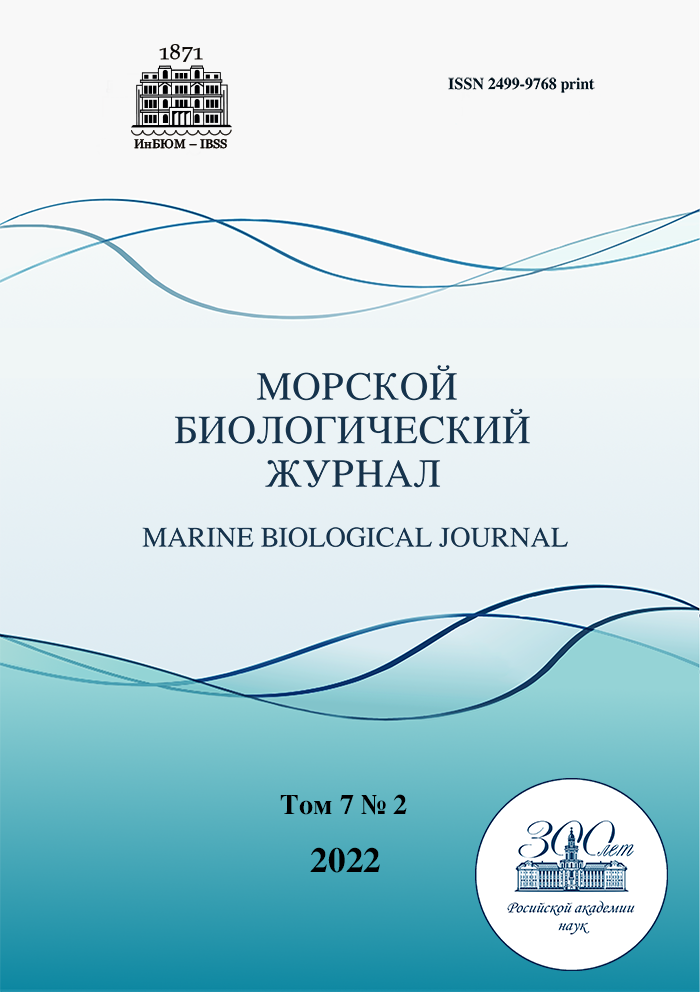Growth of the cryptophyte microalga Rhodomonas salina (Wislouch) D. R. A. Hill & R. Wetherbee, 1989 under different cultivation conditions
##plugins.themes.ibsscustom.article.main##
##plugins.themes.ibsscustom.article.details##
Abstract
Temperature and irradiance effect was studied on the specific growth rate and biomass accumulation of the cryptophyte alga Rhodomonas salina. Optimal conditions for its cultivation were determined allowing to obtain the maximum biomass. R. salina was cultivated on the Conway medium (in our own modification) at a temperature of (20 ± 1), (24 ± 1), and (28 ± 1) °C and irradiance of 13, 67, 135, and 202 μmol photons·m−2·s−1. As shown, an increase in temperature up to above-optimal values resulted in a decrease of the microalga growth rate and biomass. For R. salina, there were no significant differences in growth rates at irradiance of 135 and 202 μmol photons·m−2·s−1 (μ values were of (0.69 ± 0.04) and (0.64 ± 0.02) day−1, respectively). The microalga growth slowed down at low irradiance (13 μmol photons·m−2·s−1) (μ value was of (0.33 ± 0.03) day−1). The maximum biomass [(3.74 ± 0.28) g·L−1] was obtained at the optimal temperature [(24 ± 1) °C] and irradiance of 135 μmol photons·m−2·s−1. Under optimal cultivation conditions, maximum accumulation of proteins was registered at the exponential growth phase (29 %), and maximum accumulation of lipids was recorded at the stationary phase (41 %).
Authors
References
Ладыгина Л. В. Микроводоросль Rhodomonas salina – перспективный кормовой объект в аквакультуре моллюсков // Экология моря. 2010. Вып. 81. С. 50–53. [Ladygina L. V. Microalga Rhodomonas salina is a promising food object in mollusc aquaculture. Ekologiya morya, 2010, iss. 81, pp. 50–53. (in Russ.)]
Лакин Г. Ф. Биометрия : учебное пособие для биол. спец. вузов. Москва : Высшая школа, 1990. 352 с. [Lakin G. F. Biometriya : uchebnoe posobiye dlya biol. spets. vuzov. Moscow : Vysshaya shkola, 1990, 352 p. (in Russ.)]
Методы гидрохимических исследований основных биогенных элементов. Москва : ВНИРО, 1988. 150 с. [Metody gidrokhimicheskikh issledovanii osnovnykh biogennykh elementov. Moscow : VNIRO, 1988, 150 p. (in Russ.)]
Холодов В. И., Пиркова А. В., Ладыгина Л. В. Выращивание мидий и устриц в Чёрном море. 2-е издание, дополненное. Воронеж : Издат-Принт, 2017. 508 с. [Kholodov V. I., Pirkova A. V., Ladygina L. V. Cultivation of Mussels and Oysters in the Black Sea. 2nd ed., suppl. Voronezh : Izdat-Print, 2017, 508 p. (in Russ.)]
Bartua A., Lubián L. M., Gálvez J. A., Niell F. X. Effect of irradiance on growth, photosynthesis, pigment content and nutrient consumption in dense cultures of Rhodomonas salina (Wislouch) (Cryptophyceae). Ciencias Marina, 2002, vol. 28, no. 4, pp. 381–392. https://doi.org/10.7773/cm.v28i4.236
Brown M. R., Jeffrey S. W., Volkman J. K., Dunstan G. A. Nutritional properties of microalgae for mariculture. Aquaculture, 1997, vol. 15, iss. 1–4, pp. 315–331. https://doi.org/10.1016/S0044-8486(96)01501-3
Chaloub R. M., Motta N. M. S., Araujo S. P., Aguiar P. F., Silva A. F. Combined effects of irradiance, temperature and nitrate concentration on phycoerythrin content in the microalga Rhodomonas salina sp. (Cryptophyceae). Algal Research, 2015, vol. 8, pp. 89–94. https://doi.org/10.1016/j.algal.2015.01.008
Fernández-Reiriz M. J., Pérez-Camacho A., Ferreiro M. J., Blanco J., Planas M., Campos J. M., Labarta U. Biomass production and variation on the biochemical profile (total protein, carbohydrates, RNA, lipids and fatty acids) of seven species of marine microalgae. Aquaculture, 1989, vol. 83, iss. 1–2, pp. 17–38. https://doi.org/10.1016/0044-8486(89)90057-4
Guevara M., Arredondo-Vega B. O., Palacios Y., Saez K., Comez P. I. Comparison of growth and biochemical parameters of two strains of Rhodomonas salina (Cryptophyceae) cultivated under different combinations of irradiance, temperature and nutrients. Journal of Applied Physiology, 2016, vol. 28, no. 5, pp. 2651–2660. https://doi.org/10.1007/s10811-016-0835-2
Lowry O. H., Rosebrough N. J., Faar A. L. Protein measurement with the Folin phenol reagent. Journal of Biological Chemistry, 1951, vol. 193, iss. 1, pp. 265–275. https://doi.org/10.1016/S0021-9258(19)52451-6
Rowan K. S. Photosynthetic Pigment of Algae. New York : Cambridge University Press, 1989, 334 p.
Silva A. F., Lourenço S. O., Chaloub R. M. Effects of nitrogen starvation on the photosynthetic physiology of a tropical marine microalga Rhodomonas sp. (Cryptophyceae). Aquatic Botany, 2009, vol. 91, iss. 4, pp. 291–297. https://doi.org/10.1016/j.aquabot.2009.08.001
Vu M. T. T., Douëtte C., Rayner T. A., Vinum T. C., Nielsen S. L., Winding H. B. Optimization of photosynthesis, growth, and biochemical composition of the microalga Rhodomonas salina – An established diet for live feed
copepods in aquaculture. Journal of Applied Physiology, 2016, vol. 28, no. 3, pp. 1485–1500. https://doi.org/10.1007/s10811-015-0722-2
Tremblay R., Cartier S., Miner P., Pernet F., Quéré C., Moal J., Muzellec M., Mazuret M., Samain J. Effect of Rhodomonas salina addition to a standard hatchery diet during the early ontogeny of the scallop Pecten maximus. Aquaculture, 2007, vol. 262, no. 2–4, pp. 410–418. https://doi.org/10.1016/j.aquaculture.2006.10.009
Videla J. A., Chaparro O. R., Thompson R. J., Concha I. I. Role of biochemical energy reserves in the metamorphosis and early juvenile development of the oyster Ostrea chilensis. Marine Biology, 1998, vol. 32, pp. 635–640. https://doi.org/10.1007/s002270050428
Vonshak A. Laboratory techniques for the cultivation of microalgae. In: Handbook of Microalgae Mass Culture / A. Richmond (Ed.). Boca Raton, Florida : CRC Press, 1986, pp. 117–146. https://doi.org/10.1201/9780203712405
Whyte J. S., Bourne N., Hodgson C. A. Influence of algal diets on biochemical composition and energy reserves in Patinopecten yessoensis (Jay) larvae. Aquaculture, 1989, vol. 78, iss. 3–4, pp. 333–347. https://doi.org/10.1016/0044-8486(89)90110-5
Zhang J., Wu C., Pellegrini D., Romano G., Esposito F., Ianora A. Effects of different monoalgal diets on egg production, hatching success and apoptosis induction in a Mediterranean population of the calanoid copepod Acartia tonsa (Dana). Aquaculture, 2013, vol. 400–401, pp. 65–72. https://doi.org/10.1016/j.aquaculture.2013.02.032


 Google Scholar
Google Scholar



